Post Physical Therapy – Home Exercise Program
I live with lumbar spinal stenosis, of which there is no cure. Spinal stenosis is when the spine’s spaces narrow, putting direct pressure on the lower back’s nerves. The neck (cervical spine)—furthermore, it is mainly attributed to wear-and-tear spinal tissue and wear-and-tear related to osteoarthritis.
It is excruciating and, at times, physically debilitating. However, through an intense physical fitness regimen, I am on a quest to eliminate my pain and discomfort.
With a physical therapist’s aid, I have created a healthy regimen to accomplish this goal. This article illustrates five of the 14 exercises I performed with my physical therapist, with more to follow in future posts. My sessions were once per week, and I completed the rest of my exercises on my own five days a week.
Home Exercises
- SUPINE BRACE (aka stiffen) MARCHING targets the lower abdominal muscles and stabilizes the pelvis and back muscles.
Instructions
- Lay on your back, bend both knees, and place your feet flat on the floor, arms by your side.
- Engage your abdominal muscles, and in a slow tempo, raise one foot a few inches and slowly lower it down.
- Perform the same action with the opposite leg.
- Breathe normally.
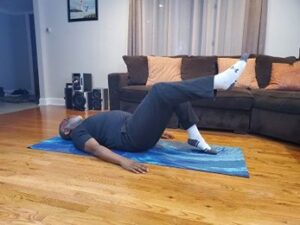
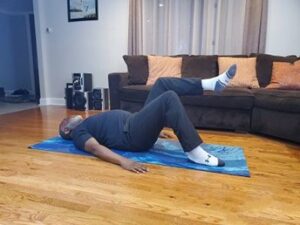
Repeat: 10 Times. Hold 1 second
Complete 3 Sets Perform 1 Time a Day
- QUADRUPED (aka bird dog) ALTERNATE ARM AND LEG WITH CONTRALATERAL KNEE ELBOW TOUCH is a full-body exercise that improves core muscle stimulation, posture management improvement, trunk rotation stability, upper and lower body coordinated performance, and much more.
Instructions
- Get on all fours in a crawling position.
- Position your knees under your hips and your hands beneath your shoulders.
- Keep your back straight and draw in your deep abdominal muscles to create a neutral spine. Breathe normally, and do not hold your breath.
- Slowly extend one leg and the opposite arm. As you return your arm and leg, tap the elbow with the opposite knee rather than touching the floor.
- Lift and straighten them again. Return your leg and hand to the floor and perform the exercise using the opposite limbs.
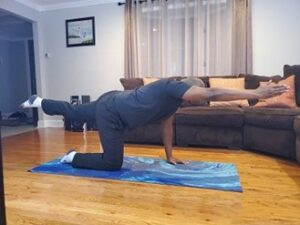
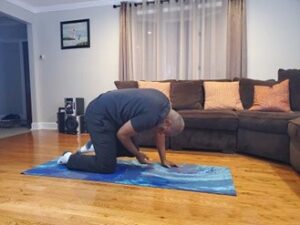
Repeat: 10 Times. Hold 1 second
Complete 3 Sets Perform 1 Time a Day
- ISO PALLOF WALKOUT Named after physical therapist John Pallof, this exercise improves rotational power by establishing strength in the lumbar spine, deep core muscles, and hips.
Instructions
- Stand with your feet shoulder-width apart. With both hands placed between the chest and abdomen, hold an elastic band or weighted cable and extend the elbows 75%.
- Bend the knees into a partial squat and push out your butt slightly. But do not arch your back.
- Pair your hips with the band/cable post to remove the lumbar spine’s pressure.
- Slowly walk away from the post, keeping your pelvis level, torso upright, and hands line between your chest and abs.
- Note: An elastic band will increase in resistance the further it stretches. Walk out only as far as you can.
- Slowly walk back and keep the same amount of control during the movement.
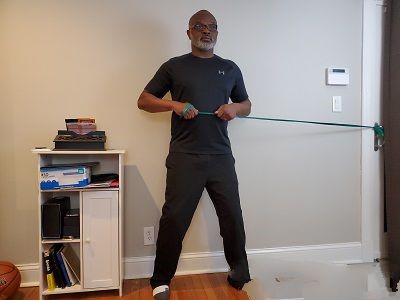
Repeat: 10 Times
Complete 3 Sets Perform 1 Time a Day
- CAT STRETCHES improves flexibility in the core muscles and extended lumbar region.
Instructions
- Get on all fours, with your knees under your hips and your shins firmly on the ground. Look down at your hands.
- Place your hands directly under your shoulders and face forward.
- Engage your core muscles by sucking in your belly button towards your spine.
- Round your back like a cat, and hold the pose for a slow count of five.

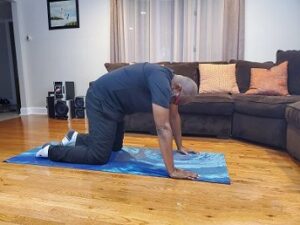
Repeat: 10 Times. Hold 5 seconds
Complete 3 Sets Perform 1 Time a Day
- KNEELING ILIOPSOAS STRETCH The Iliopsoas is a complex of muscles consisting of the iliacus, psoas major, and psoas minor and connects the spine to the femur. It contracts and externally rotates the muscles between the hips and knees.
Instructions
- Consider using a mat for a cushion. Kneel on the side that you plan to stretch, and with the other leg bent in front of you.
- Be sure to have your feet and knees straight forward.
- Rotate and tuck in the bottom of your pelvis.
- Place your hands on your hips and keep your posture alert and upright.
- Slowly lean forward to feel a stretch in your pelvis muscles, thighs, and knee. Squeeze your glutes during the movement.
- Hold the position for approximately 30 seconds.
- Please note that you should not feel back pain. Slowly release the stretch and readjust your back into a neutral position. Try rotating the bottom of your pelvis forward or backward as needed.
- Repeat the movement with the opposite leg.
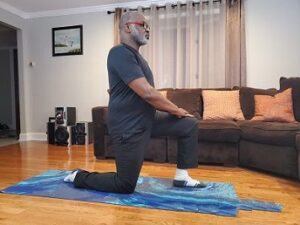
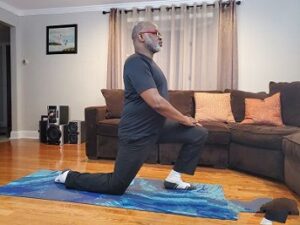
Perform 1 Time for each leg. Hold 30 Seconds
Complete 3 Sets Perform 1Time a Day
Conclusion
Recovering from injuries or dealing with chronic conditions like spinal stenosis can be very difficult. I go through setbacks nearly daily. Getting out of bed is sometimes challenging, and sitting for prolonged periods is painful.
Exercising sometimes takes discomfort to a whole new level. But I have been in health and fitness long enough to know these setbacks are temporary. As I get stronger and continue to build my endurance, increase my flexibility, and lose weight, little by little, I will be at a stage where it will all pay off.
For all of us, meaningful effort and consistency are the keys to success. Get up and start today, and you will be surprised at your progress after 12 months.
Source
- Spinal Stenosis – Mayo Foundation for Medical Education and Research (MFMER)
- Spinal Stenosis – Arthritis Foundation
- TA Brace Marching Supine – Indy Sports Rehab
- Quadruped bird dog – Micah Frey
- Cat Camel – Mobility Exercise for Lower Back Pain – Northallerton Osteopaths at Hale House
- Kneeling Psoas Stretch – Inspire Chiropractic & Wellness Studio
Before starting any new health and fitness program or taking supplements, it’s crucial to consult with your healthcare professional. They can provide personalized advice based on your medical history and current health status, ensuring your new regimen is safe and effective. This step helps prevent potential health risks and ensures that any changes you make are beneficial and sustainable in the long run. Your healthcare professional is your best resource for making informed decisions about your health and wellness journey.



